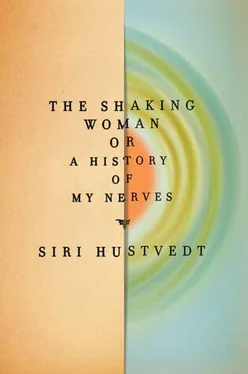EVERY SICKNESS HAS an alien quality, a feeling of invasion and loss of control that is evident in the language we use about it. No one says, “I am cancer” or even “I am cancerous,” despite the fact that there is no intruding virus or bacteria; it’s the body’s own cells that have run amok. One has cancer. Neurological and psychiatric illnesses are different, however, because they often attack the very source of what one imagines is one’s self. “He’s an epileptic” doesn’t sound strange to us. In the psychiatric clinic, the patients often say, “Well, you see, I’m bipolar” or “I’m schizophrenic.” The illness and the self are fully identified in these sentences. The shaking woman felt like me and not like me at the same time. From the chin up, I was my familiar self. From the neck down, I was a shuddering stranger. Whatever had happened to me, whatever name would be assigned to my affliction, my strange seizure must have had an emotional component that was somehow connected to my father. The problem was that I hadn’t felt emotional. I had felt entirely calm and reasonable. Something seemed to have gone terribly wrong with me, but what exactly? I decided to go in search of the shaking woman.
PHYSICIANS HAVE BEEN PUZZLING over convulsions like mine for centuries. Many diseases can make you shudder, but it’s not always easy to separate one from the other. From Hippocrates onward, making a diagnosis has meant herding a cluster of symptoms under a single name. Epilepsy is the most famous of all the shaking illnesses. Had I been a patient of the Greek physician Galen, who ministered to the emperor Marcus Aurelius and whose copious writings influenced medical history for hundreds of years, he would have diagnosed me with a convulsive illness, but he would have ruled out epilepsy. For Galen, epilepsy not only caused convulsions of the entire body, it interrupted “leading functions”—awareness and speech. 1Although there were popular beliefs among the Greeks that gods and ghosts could make you shake, most physicians took a naturalist view of the phenomenon, and it wasn’t until the rise of Christianity that tremors and the supernatural were bound together with bewildering intimacy. Nature, God, and the devil could wrack your body, and medical experts struggled to distinguish among causes. How could you separate an act of nature from a divine intervention or a demonic possession? Saint Teresa of Avila’s paroxysmal agonies and blackouts, her visions and transports were mystical flights toward God, but the girls in Salem who writhed and shook were the victims of witches. In A Modest Inquiry into the Nature of Witchcraft, John Hale describes the fits of the tormented children and then pointedly adds that their extreme sufferings were “beyond the power of any epileptic fits or natural disease to effect.” 2If my tremulous episode had occurred during the witch madness in Salem, the consequences might have been dire. Surely I would have looked like a woman possessed. But, more important, had I been steeped in the religious beliefs of the age, as I most likely would have been, the weird sensation that some external power had entered my body to cause the shudder probably would have been enough to convince me that I had indeed been hexed.
In New York City in 2006 no sane doctor would have sent me to an exorcist, and yet confusion about diagnosis is common. The frames for viewing convulsive illness may have changed, but understanding what had happened to me would not be a simple matter. I could go to a neurologist to see if I had come down with epilepsy, although my past experience in the ward at Mount Sinai Hospital had left me wary of the doctors in charge of investigating nervous systems. I knew that in order to be diagnosed with the disease, I needed to have had at least two seizures. I believed I had had one genuine seizure before my intractable migraine. The second one looked suspicious to me. Uncontrollable shaking can occur in some seizures. My shaking was on both sides of my body — and I had talked throughout the fit. How many people talk through a seizure? Also, I had had no aura, no warning that some neurological event was in the making, as I often do for migraine, and it had come and gone with the speech about my dead father. Because of my history, I knew that a careful neurologist would do an EEG, an electroencephalogram. I’d have to sit with gooey electrodes clamped onto my scalp for quite a while, and my guess is that the doctor would find nothing. Of course, many people suffer from seizures that are not detected by standard tests, so the physician would have to do more tests. Unless I kept shaking, a diagnosis might not be forthcoming. I could float in the limbo of an unknown affliction.
I had puzzled for some time over my shaking when a possible answer announced itself. It didn’t appear slowly but came all at once as an epiphany. I was sitting in my regular seat at the monthly neuroscience lecture, and I remembered a brief conversation I had had with a psychiatrist who had been sitting behind me at an earlier talk. I’d asked her where she worked and what she did, and she’d told me she was on the staff in a hospital, where she saw mostly “conversion patients.” “The neurologists don’t know what to do with them,” she’d said, “so they send them to me.” That could be it! I thought. My fit had been hysterical. This ancient word has been mostly dropped from current medical discourse and replaced by conversion disorder, but lying beneath the newer term is the old one, haunting it like a ghost.
Nearly every time the word hysteria is used now in newspapers or magazines, the writer points out that the root comes from the Greek for “womb.” Its origin as a purely female problem connected to reproductive organs serves to warn readers that the word itself reflects an ancient bias against women, but its history is far more complicated than misogyny. Galen believed that hysteria was an illness that beset unmarried and widowed women who were deprived of sexual intercourse but that it wasn’t madness, because it didn’t necessarily involve psychological impairments. Ancient doctors were well aware that epileptic fits and hysterical fits could look alike, and that it was essential to try to distinguish between the two. As it turns out, the confusion has never disappeared. The fifteenth-century physician Antonius Guainerius believed that vapors rising from the uterus caused hysteria and that hysteria could be distinguished from epilepsy because the hysterical person would remember everything that had happened during the fit. 3The great seventeenth-century English doctor Thomas Willis dispensed with the uterus as the offending organ and located both hysteria and epilepsy in the brain. But Willis’s thought didn’t rule the day. There were those who believed that the two were merely different forms of the same disease. The Swiss physician Samuel Auguste David Tissot (1728–1797), who has remained part of medical history mostly for his widely published treatise on the dangers of masturbation, maintained that the two illnesses were distinct, despite the fact that there were epilepsies that originated in the uterus. 4From ancient times through the eighteenth century, hysteria was regarded as a convulsive illness that originated somewhere in the body — in the uterus or the brain or a limb — and the people suffering from it weren’t considered insane. It is safe to say that if any one of the doctors above had witnessed my convulsive speech, he might have diagnosed me with hysteria. My higher functions weren’t interrupted; I remembered everything about my fit; and, of course, I was a woman with a potentially vaporous or disturbed uterus.
It’s interesting to ask when hysteria became an illness associated exclusively with the mind. In ordinary speech we use the word hysteria to indicate a person’s excitability or excessive emotion. It conjures up a screaming out-of-control person, usually a woman. Whatever was happening to my arms, legs, and torso, my mind was all right, and I spoke calmly. I wasn’t hysterical in that sense. Today, conversion disorder is classified as a psychiatric, not a neurological disorder, which explains why we connect it to mental problems. In the DSM, now in its fourth edition, conversion disorder is included among the somatoform disorders — disturbances of the body and physical sensations. 5But in the last forty years, the term for and classification of the illness has changed several times. In the first DSM (1952) it was called conversion reaction . The DSM-II (1968) grouped it with dissociation disorders and identified it as hysterical neurosis, conversion type . In 1968, the authors were apparently eager to reinstate the roots of the illness by bringing back the word hysteria. Dissociation is a very broad term used in different ways to indicate some form of distance from or disruption of ordinary selfhood. For example, when a person has an out-of-body experience, he is said to be in a dissociated state; someone who is plagued by a sense that he or the world isn’t real would also be called dissociated. By the time the DSM-III (1980) came out, the word hysterical had vanished, and the term had been changed to conversion disorder, a somatoform problem, which was left unchanged in the DSM-IV. The current manual of the World Health Organization, the ICD-10 (1992), however, disagrees. There it’s called dissociative (conversion) disorder . If this sounds confusing, it is. The authors of psychiatric diagnostic texts have obviously been uncertain about what to do with hysteria.
Читать дальше












